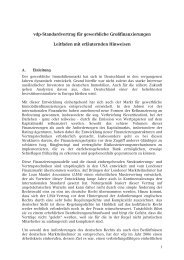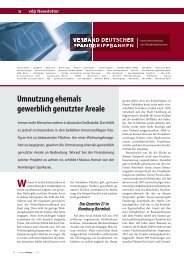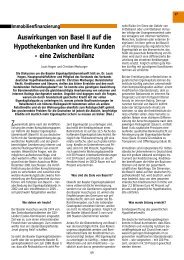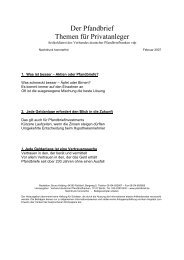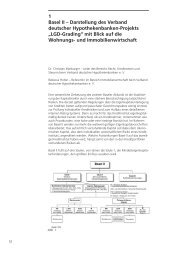The Pfandbrief 2011 | 2012
The Pfandbrief 2011 | 2012
The Pfandbrief 2011 | 2012
You also want an ePaper? Increase the reach of your titles
YUMPU automatically turns print PDFs into web optimized ePapers that Google loves.
Solvency II is intended to reform the system of insurance regulation currently<br />
in place in Europe (Solvency I). <strong>The</strong> aim is to establish a risk-based<br />
and market-oriented system in order to further improve the supervision of<br />
the risk-bearing capacity of European insurance companies – and thus to<br />
better protect consumers.<br />
<strong>The</strong> Solvency II Framework Directive was adopted in the EU Parliament<br />
on 22 April 2009 and by the European Council on 10 November 2009. On<br />
17 December 2009, it was finally published in the Official Journal of the<br />
European Union (EU). <strong>The</strong> Directive will be given concrete form through<br />
“delegated acts” and implementing acts. <strong>The</strong>se acts must be approved<br />
before the planned start date of Solvency II on 1 January 2013 in order to<br />
ensure the coherent implementation of the new supervisory regime.<br />
<strong>The</strong> new supervisory regime in the insurance sector is based on three pillars. <strong>The</strong> first<br />
pillar involves capital adequacy for insurers. A standardised approach will be applied to<br />
determine an insurer’s capital adequacy, which can then be used in future to determine its<br />
capital requirements. <strong>The</strong> alternative to this standardised approach is an internal risk model<br />
recognised by the supervisory authorities, which must be developed separately for each<br />
undertaking. <strong>The</strong> European Commission and the European supervisory authority, EIOPA,<br />
have made use of a number of studies to review the impact of drafts of the standardised<br />
approach. <strong>The</strong> most recent impact study was QIS5, which was carried out across Europe<br />
in autumn 2010. <strong>The</strong> quantitative approach of the first pillar is complemented by the qualitative<br />
risk management requirements placed on insurers by the second pillar, as well as the<br />
corresponding reporting requirements of the third pillar.<br />
This paper presents an introduction to the classification system of Solvency II. <strong>The</strong> focus<br />
is on the calculation of capital requirements using the standardised approach laid down in<br />
the first pillar. This highlights critical issues concerning <strong>Pfandbrief</strong>e. <strong>Pfandbrief</strong>e play a major<br />
role in investments made by German insurers: around one-quarter of their total investments<br />
as at the end of 2010 were in this product group. <strong>The</strong> future supervisory treatment of the<br />
<strong>Pfandbrief</strong> established by the delegated acts and implementing acts is therefore of clear<br />
interest to investors. This paper largely ignores the second and third pillars of Solvency II.<br />
Seit 2003 nahm die Taktzahl der Novellierungen des Rechtsrahmens für die <strong>Pfandbrief</strong>emittenten<br />
deutlich zu: die Abschaffung der Gewährträgerhaftung und die Modifizierung der<br />
Anstaltslast, die zunehmende Bedeutung gemischter gegenüber reinen Hypothekenbanken,<br />
die Internationalisierung des <strong>Pfandbrief</strong>absatzes und der aufkommende Wettbewerb mit ausländischen<br />
Covered Bonds waren wesentliche Beweggründe des Gesetzgebers für die Schaffung<br />
des <strong>Pfandbrief</strong>gesetzes, das Hypothekenbankgesetz, Öffentliches <strong>Pfandbrief</strong>gesetz sowie<br />
das Schiffsbankgesetz im Jahr 2005 auf sich vereinte und grundlegend neu gestaltete. Über<br />
die Abkehr vom Spezialbankprinzip hinaus wurden weitere Neuerungen wie eine verbesserte<br />
Regulierung der Überdeckungsanforderungen, Transparenzvorschriften des § 28 PfandBG<br />
sowie Anforderungen an das Liquiditätsmanagement der Deckungsmassen in das Gesetz aufgenommen.<br />
Diese Maßnahmen wurden ermöglicht bzw. maßgeblich flankiert durch die Schaffung<br />
der Rolle des Sachwalters im Jahr zuvor, durch den die insolvenzrechtliche Abschottung<br />
der Deckungsmassen perfektioniert wurde.<br />
Im Folgenden werden die praktischen und gesetzlichen Anforderungen an das Deckungsgeschäft<br />
einer <strong>Pfandbrief</strong>bank im aktuellen regulatorischen Umfeld beschrieben und am<br />
Beispiel einer zentralen Organisation des Deckungswesens gezeigt, wie diesen Anforderungen<br />
in der Praxis Rechnung getragen werden kann.<br />
37




